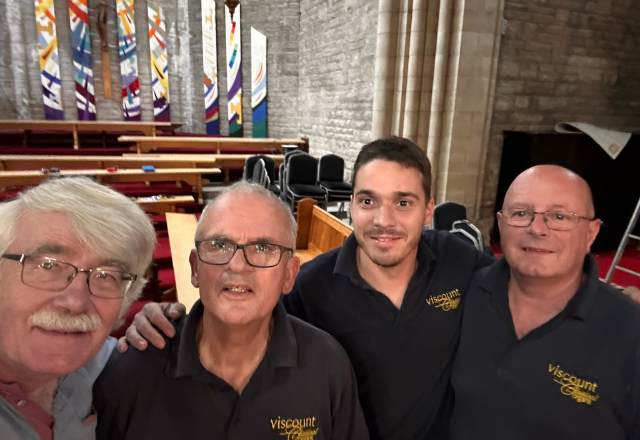Late in 2022 we were asked to quote for the rebuild of the Copeman Hart instrument originally installed in the College Chapel sometime in the 1990’s. It was first installed on the west end gallery where a pipe organ had once been sited.
This is a large and impressive building which, at least amongst those familiar with school chapels I gather is known as the Lancing of the North. It certainly is a building of scale, very tall and long seating near 700 at capacity.
What led us to be invited to help with a rebuild
At some point in the 2000s the school moved the instrument from the west to the east end. This was no mean feat, as the instrument played through approximately 20 very large external speaker cabinets! These were also moved from the west gallery to new locations in the arched openings between the nave and the chancel.
Two walls of speakers were created in a “Lego” style in the spaces with ratchet straps tying the speaker columns together. The speakers faced both east and west almost in equal numbers.
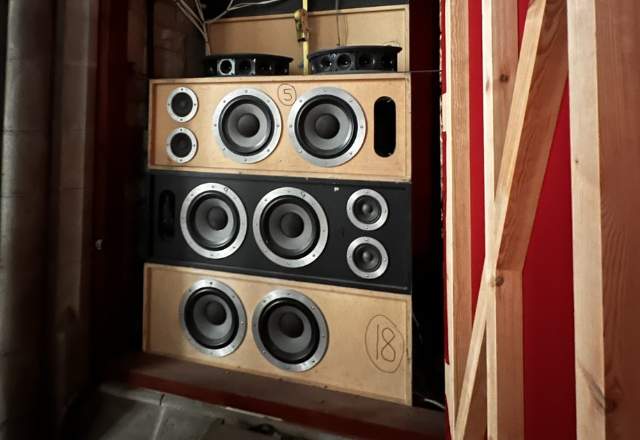
Unfortunately, when the college staff were relocating the speakers they didn’t appreciate that each speaker broadcasted a particular part of the instrument and the rebuild of the speaker array jumbled everything up. With almost equal volume being directed into the small apse as was directed at the nave – the new set-up was far from ideal and the result had never been good from that time on.
More recently there have been internal electrical issues that have required repair gradually reaching a point when a more thorough rebuild of the instrument became desirable.
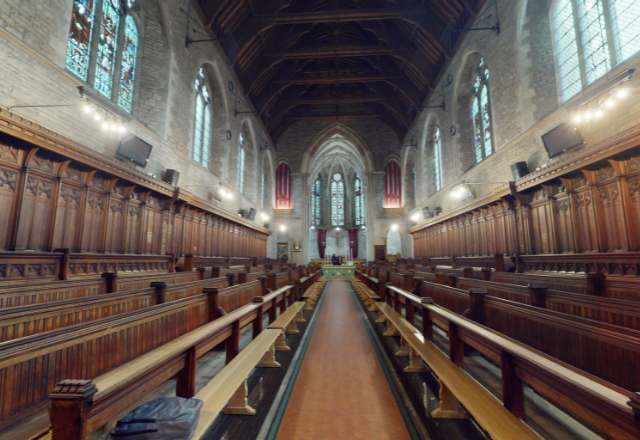
Improvements we added to the instrument
This instrument is a particularly large Copeman Hart, with 75 speaking stops over 5 divisions. The choir manual controlling an additional positive division which, when active, silences any choir stops that are drawn – preventing both departments speaking together.
A number of improvements were built into the new rebuilt instrument:
- The positive was brought under expression requiring a rebuild of the toe sweeps to add a 3rd swell shoe.
- A set of divisional pistons were added for the positive sitting above the swell manual.
- General pistons on swell toes was enabled by means of a tiny push button switch above the swell, a feature I have seen on other Copeman Hart consoles (we added a new draw stop to manage this facility more conventionally).
- A stepper facility was added with a set of discrete LED lights placed above the general pistons to indicate which piston was active as the stepper advanced through the general pistons.
- 32 ft reverser thumb pistons were added.
- New keyboards were fitted with velocity sensitivity to allow the full voicing capability of the Physis-based sound generation to be exploited.
Changes to the console were relatively modest, however the same could not be said for the speaker system. This developed into the most challenging speaker installation we have ever carried out.

Objectives of the rebuild of the Denstone Copeman Hart organ
One of the objectives of the rebuild was to reopen the two lancet style arches that separated the nave from the chancel. These locations disguised by red speaker cloth and some dummy organ pipes were never ideal speaker positions, so giving them up was an easy option to accommodate but the new locations were far from obvious to choose.
An instrument of 75 speaking stops (see full stop list of the rebuilt instrument) needs at least 20 independent speaker cabinets to work at its best. The only place in the chapel that provided an invisible location was 10 metres above ground level at the junction of the roof and the walls. This is very often a location of choice when it can be easily accessed by ladder or scaffold tower. But as raked choir stalls ran the full length of both north and south sides and the height was extreme, only a purpose-built scaffold structure would allow safe working.
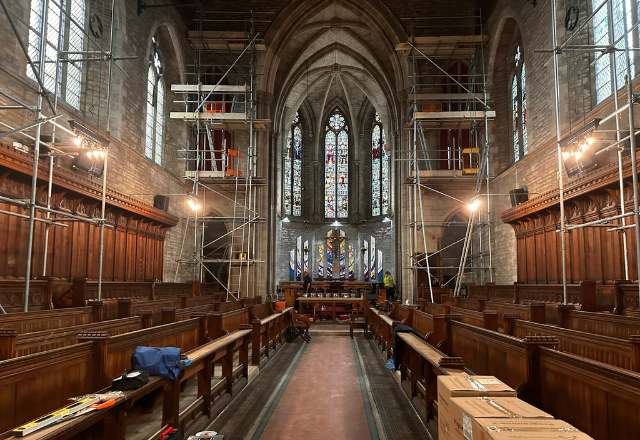
This was a massive expense eventually taking up near 20% of the final cost of the project. Speakers could have been placed lower on the nave window sills or lower still above the wooden panelling on north and south sides. However, the visual intrusion would have been very disruptive and the locations far less acoustically satisfactory so the school bravely decided to take the expense on the chin.
The very high-level speaker installation was carried out in the summer of 2023, just after a wedding booking – leaving just two weeks before the school returned from summer holiday!
And now…the speakers!
Without being able to get to the wall plate to get accurate measurements we had no certainty that our preferred speaker would fit between the ashlar posts and sit invisibly in the space behind. Neither were we certain how we would get cables along the wall plate to the east end of the chapel and from there down to the console.
To save cost we erected a scaffold in the centre of the nave where the speakers were to be placed and then a scaffold at the east end to assist with the removal of the Copeman Hart cabinets.
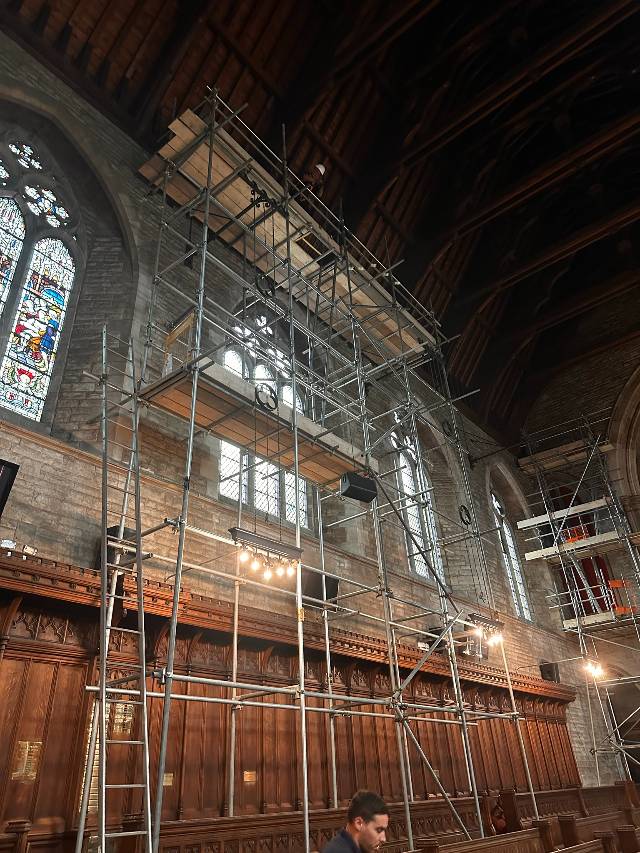
Between these two scaffolds was a gap of some 10 meters where we had assumed we could somehow get the cables through by means of threading a rod behind the ashlar posts to draw the cables back to the central section. If this did not work we would be stumped and urgently needed more scaffolding, but all roofs of this design have that gap, don’t they?
Whether it was luck or judgement the plan worked and by means of threading a drain rod along the roof wall plate we bridged the gap between our scaffold structures and the 5 cables needed to drive the central nave speakers were successfully pulled back from the east end. The cable route from ground floor level was approximately 40 meters so we had to build a small stand to allow this considerable length of cable to be pulled in a single manoeuvre from the floor up to the wall plate and then down the nave to the central zone.
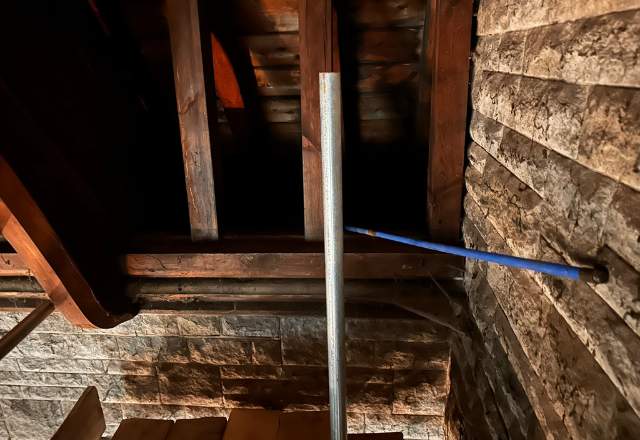
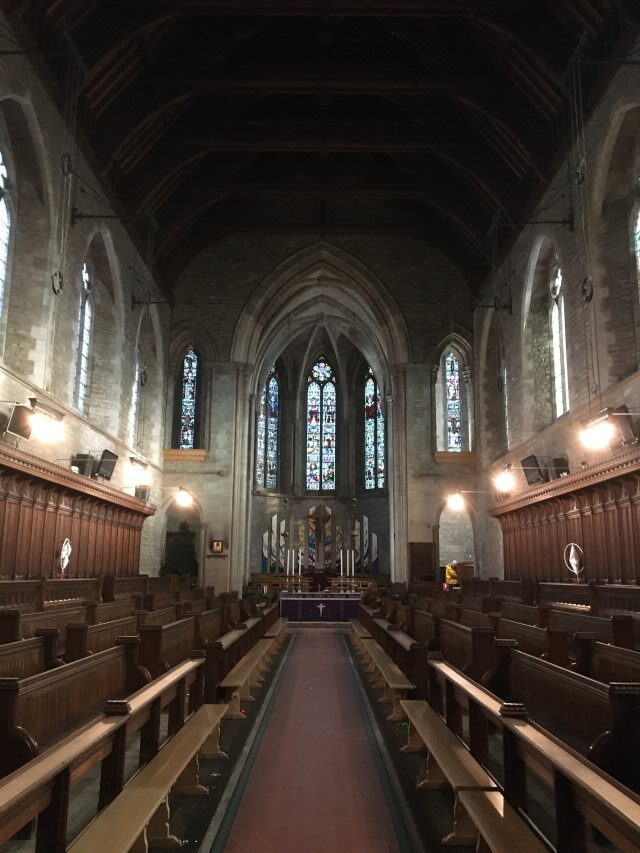
And then to install the rebuilt instrument
Our loan instrument remained in place until the rebuilt console was installed during the October half-term.
It goes without saying: is any organ ever without snags on first installation? There are many pipe organs where one hears stories that they never actually get finished at all or at least take many months to bed in and become snag free. The same can be true but to a much lesser extent with digital instruments and we were not without a couple of gremlins on this complex initial installation!
Some of our snags: included: our LED lights above the general pistons did not work and Swell on general toes worked back to front. The Choir Contra Viola came on but would not go off unless general cancel was operated.
But other than that, the instrument was all functioning. With a snagging list prepared we retreated for a couple of weeks to revise software – returning with some new hardware and the software revision that cleared all the issues.
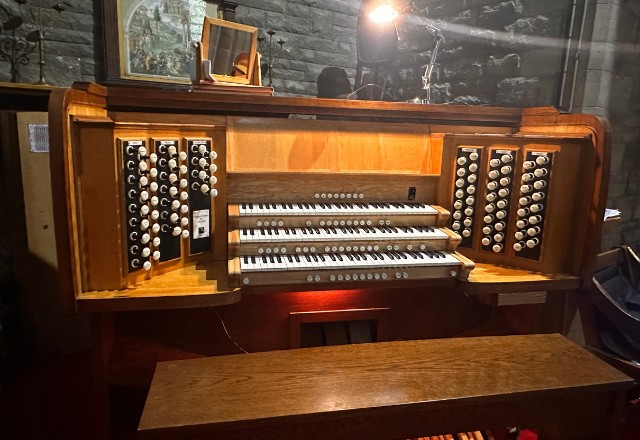
Voicing and putting the organ to the test with an audience
A very preliminary voicing had been carried out to allow the instrument to be played for services with the Remembrance Day service being the first big test which it passed well.
A two-day detailed voicing is planned for the last week of the Winter term (Dec 2023) which can take full advantage of the feed back from its early use.
Already its contemplated to make a change to allow both choir and positive divisions to be played together. The sound now comes from very different locations so the organist is having to get used to registering differently.
The console is located in the choir so the impression at the console is of a quieter Great and Swell (not actually the case when standing in the nave) while the apse speakers that carry the choir division are now much closer to the organist also changing perception of that department.
There is no doubt a few months of use will be needed to revise the past registration regime and get used to the greatly relocated speaker distribution. So in the case of this rebuild project, perhaps more so than in many locations – the second voicing visit in 2024 will be more important than is usually the case.
This has been a challenging project involving many months coordinating work load with external contractors and the school calendar. Its really rewarding seeing that work come together and this interesting instrument have a new lease of life to take it well into the 21st century.
Increase in rebuild enquiries
It’s interesting that in recent months a significant number of enquiries have reached us for rebuild of quality digital instruments from the 1980’s and 1990’s. (You may have read about our other installation at All Saints Wokingham.)
It has been routine for pipe organs to be rebuilt and dare I say that no-one blinks an eye at huge sums invested on a 30 to 40 year-cycle to restore real pipe instruments. Now it seems quality digital instruments are receiving the same treatment.
I have had a passion for church organs since the tender age of 12. I own and run Regent Classic Organs with a close attention to the detail that musicians appreciate; and a clear understanding of the benefits of digital technology and keeping to the traditional and emotional elements of organ playing.
